Learning the Importance of Dealing with a Leaking Faucet
Learning the Importance of Dealing with a Leaking Faucet
Blog Article
This great article below about Why Is It Important To Fix Your Leaking Tap/Faucet? is exceptionally compelling. Don't miss it.

Dripping faucets may appear like a small trouble, but their influence exceeds just the annoyance of the sound. From wasting water to incurring unnecessary financial costs and health risks, ignoring a dripping faucet can lead to numerous effects. In this write-up, we'll look into why it's critical to resolve this typical home issue promptly and effectively.
Wastefulness of Water
Environmental Impact
Trickling faucets contribute dramatically to water waste. According to the Environmental Protection Agency (EPA), a solitary faucet dripping at one drip per secondly can waste greater than 3,000 gallons of water per year. This not just pressures water resources yet also impacts communities and wild animals dependent on them.
Step-by-Step Overview to Fixing a Dripping Tap
Devices Required
Before trying to repair a leaking tap, gather the required tools, including a flexible wrench, screwdrivers, substitute components (such as washers or cartridges), and plumber's tape.
Typical Faucet Issues and Their Solutions
Recognize the sort of tap and the specific issue triggering the drip. Typical issues consist of damaged washing machines, corroded valve seats, or faulty O-rings. Refer to manufacturer instructions or online tutorials for step-by-step guidance on repairs.
Financial Costs
Increased Water Costs
Past the ecological effect, leaking faucets can blow up water costs substantially. The gathered wastefulness gradually translates right into greater utility expenditures, which might have been prevented with prompt repair services.
Prospective Home Damage
Additionally, prolonged trickling can result in damage to components and surfaces bordering the faucet. Water build-up can cause staining, deterioration, and even architectural issues if left ignored, causing extra fixing costs.
Wellness Issues
Mold And Mildew and Mold Growth
The constant presence of moisture from a trickling tap develops an ideal setting for mold and mildew development. These fungis not only endanger interior air quality however also posture health and wellness risks, especially for people with respiratory system problems or allergic reactions.
Waterborne Diseases
Stationary water in dripping faucets can end up being a breeding place for bacteria and other microorganisms, raising the risk of waterborne diseases. Pollutants such as Legionella microorganisms flourish in stationary water, possibly resulting in serious health problems when consumed or breathed in.
Do it yourself vs. Specialist Repair
Advantages and disadvantages of DIY Repair Work
While some may attempt to take care of a trickling faucet themselves, do it yourself repair work feature their own collection of obstacles. Without appropriate understanding and tools, DIY attempts can intensify the problem or result in incomplete repairs, lengthening the issue.
Benefits of Working With a Specialist Plumber
Working with a specialist plumber makes sure that the underlying root cause of the dripping tap is resolved successfully. Plumbing professionals have the know-how and equipment to detect and repair tap problems effectively, conserving time and reducing the threat of further damage.
Ecological Responsibility
Private Payment to Conservation
Taking obligation for dealing with dripping taps aligns with more comprehensive initiatives toward water preservation and ecological sustainability. Every individual's actions collectively make a considerable effect on maintaining precious resources.
Lasting Living Practices
By focusing on prompt repair services and embracing water-saving routines, individuals add to lasting living methods that benefit both existing and future generations.
Safety nets
Regular Maintenance Tips
To prevent dripping taps, execute regular upkeep such as cleaning aerators, checking for leaks, and changing damaged components without delay. Furthermore, think about installing water-saving gadgets or upgrading to a lot more reliable components.
Significance of Prompt Repairs
Dealing with trickling taps as quickly as they're seen avoids further water wastefulness and potential damages, ultimately saving both water and money over time.
Effect On Property Worth
Perception of Well-Maintained Residential Or Commercial Property
Keeping a property in good condition, including dealing with maintenance concerns like trickling faucets, boosts its regarded worth and worth among prospective purchasers or tenants.
Influence on Resale Value
Properties with properly maintained plumbing fixtures, including faucets, command higher resale worths in the real estate market. Addressing dripping taps can add to a favorable impact during home assessments and settlements.
Final thought
Attending to a dripping tap surpasses mere benefit; it's a crucial step towards preserving water, decreasing monetary prices, and guarding health and building. Whether with do it yourself repair work or professional assistance, taking action to take care of dripping faucets is a tiny yet impactful way to advertise accountable stewardship of resources and contribute to a healthier, a lot more lasting future.
How to Fix a Dripping or Leaky Faucet
A leaking faucet is one of the most common problems that homeowners encounter, but it being commonplace doesn’t make it any less annoying. The constant drip drip drip of a leaking bathtub faucet, showerhead, or sink tap can disturb your home’s serenity. Left neglected, a dripping faucet can also result in higher water bills and discoloration or mold growth in your sink or plumbing fixtures.
Fortunately, you don’t have to be a trained plumber to know how to stop a dripping faucet. With some basic tools, replacement parts, and a little patience, leaky faucet repair is a breeze. In this article, we’ll explain what causes dripping faucets and how you can fix them.
What Causes a Leaking Faucet?
Kitchen and bathroom faucets come in all manner of designs, but most involve some combination of valves, O-rings, seals, and washers. The O-ring is usually the weakest link, but any one of these pieces can wear down over time. Heat, moisture, temperature fluctuations, minerals, mold, and movement can contribute to warping and corrosion, breaking the watertight seal. This just comes with the territory of being a homeowner. Everything is always subject to wear and tear, and some component parts of your appliances and fixtures need to be replaced on occasion. At least replacement O-rings are cheap!
More rarely, dripping faucets can be a symptom of excessively high water pressure. Were this the case in your home, you would probably notice that the leak is not isolated to one faucet. Water pressure issues are harder to resolve on your own. We recommend contacting a professional plumber if you suspect your water pressure is too high.
How to Fix a Dripping Faucet
Pipe wrench or monkey wrench Allen wrench set Screwdrivers Old towel or rag Shut off the water.
Before you do anything, you need to turn off the water to keep from drenching your kitchen or bathroom. You should find a valve under the sink and against the wall. Once you’ve turned this valve, try turning the faucet on to confirm that the water source has been cut off.
If you can’t locate your local valve for the faucet you’re working on, you can always shut off the water to the house at the main valve. Of course, this will prohibit anyone from using the sinks, showers, or toilets while you’re working on the faucet that’s giving you trouble.
Plug or block the drain.
You’ll be disassembling the faucet and removing some small bits of hardware. Plug the drain with a stopper or rag to avoid the possibility of a small screw falling into your P-trap.
Take apart the faucet assembly.
There are several varieties of kitchen and bathroom faucets, each with its own manner of assembly. For detailed instructions on how to disassemble your faucet, you can refer to the fixture’s manual or contact the manufacturer. If you know whether you have a ball, disc, cartridge, or compression faucet, you can find detailed schematics online.
In general, you need to begin by removing the faucet handles. You might notice a small screw that you’ll need to remove with a screwdriver or Allen wrench. If you don’t see any visible securing hardware, it’s likely hidden under a decorative cap that can be unscrewed or popped off with flathead screwdriver.
Remove each piece methodically, consulting a schematic when necessary. Take notes or arrange the pieces in such a way to make it easier to correctly reassemble the faucet later.
Remove the cartridge.
Once you’ve removed the handles and securing hardware, you should be able to remove the valve cartridge or stem. Some cartridges will slide right out. Other faucet models will require you to loosen a nut with a pipe wrench before you can remove the valve stem.
Examine the exposed hardware.
With the cartridge or stem removed, inspect the component parts. Check the rubber O-rings for wear and tear. Also examine the seat washer for corrosion or other damage. These pieces are usually the responsible parties for a dripping faucet, but it’s worth inspecting the other component parts while you have the faucet disassembled.
Find replacement parts.
Once you’ve identified which faucet component has failed, find an identical replacement. Your local hardware store should have O-rings, seat washers, and other standard components in stock. If you have a luxury or uncommon faucet, you may have to contact the manufacturer for a replacement part.
It’s a good idea to take your old parts with you to the hardware store so you can compare them with the store’s inventory and be sure you’re purchasing the correct replacement.
Reassemble the faucet.
With your new parts in hand, reconstruct the faucet and handles. Don’t be tempted to overtighten screws or nuts. You might think this could create a better seal, but it can instead damage or bend a delicate part of the assembly and create a new problem for you.
Turn on the water and test the faucet.
The only thing left to do is test your work. Unplug the sink, turn the water back on, and try the faucet. Congratulate yourself on a job well done!
https://www.libertyhomeguard.com/how-to-fix-a-dripping-or-leaky-faucet/

Do you appreciate reading about Water Dripping from Faucet: Why and How to Fix? Give a remark down below. We will be glad to know your reactions about this article. We are looking forward that you come back again in the near future. Those who liked our page kindly make sure you remember to share it. I praise you for being here. Please stop by our blog back soon.
Report this page